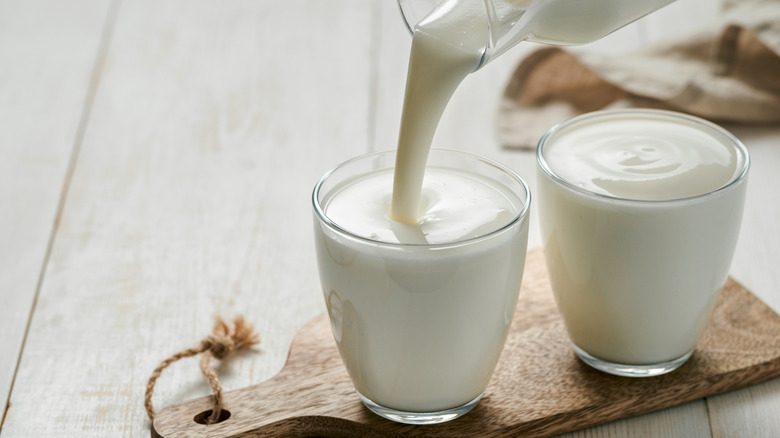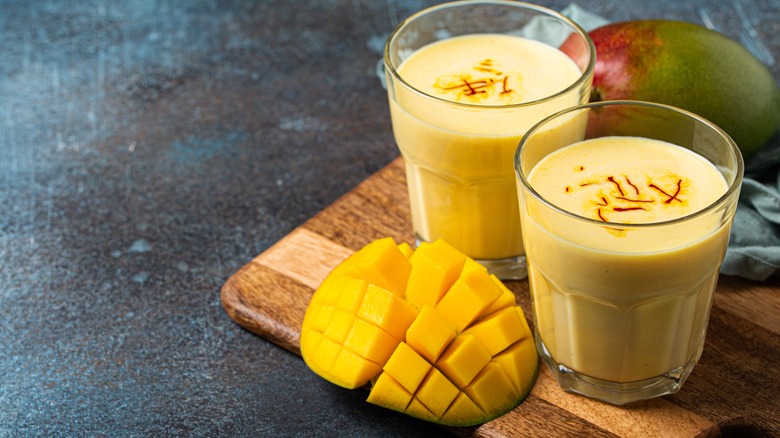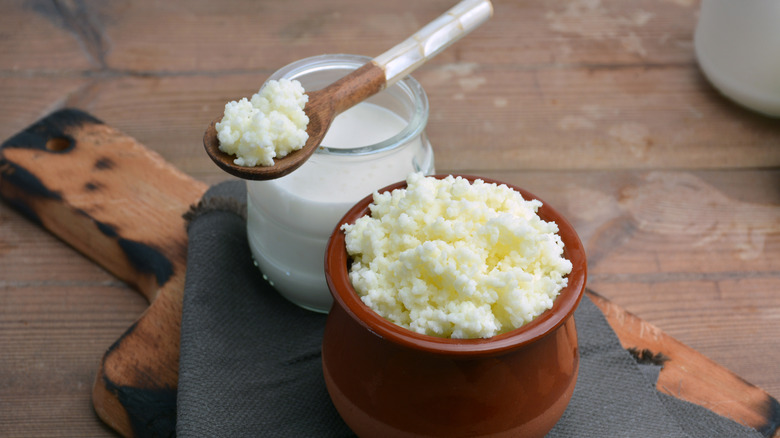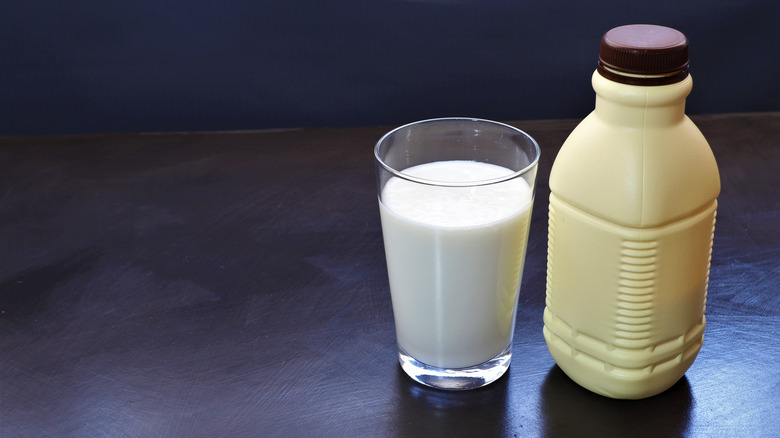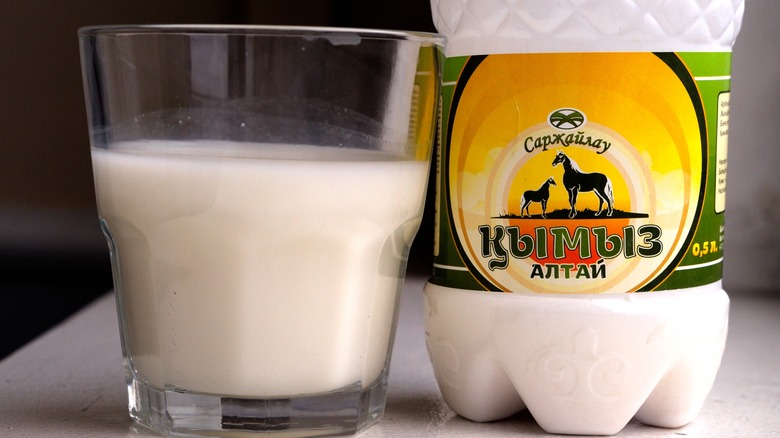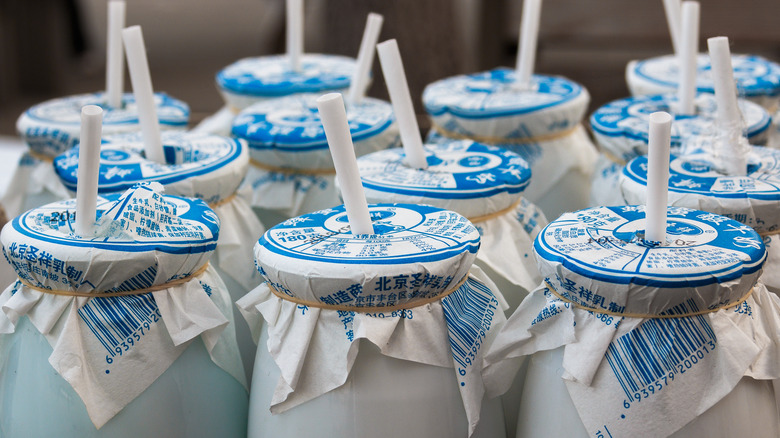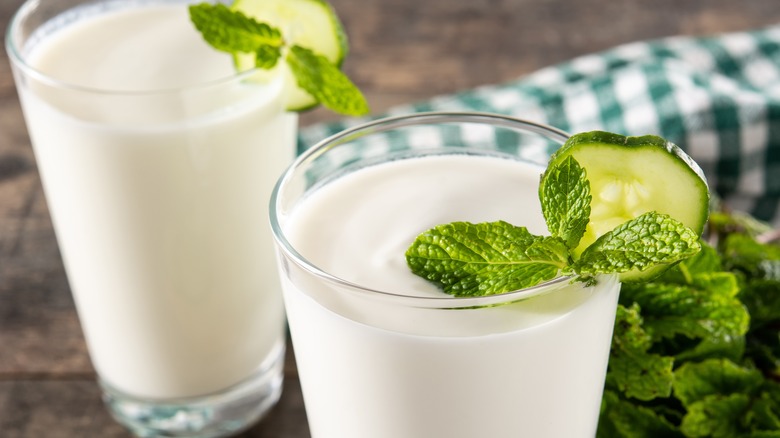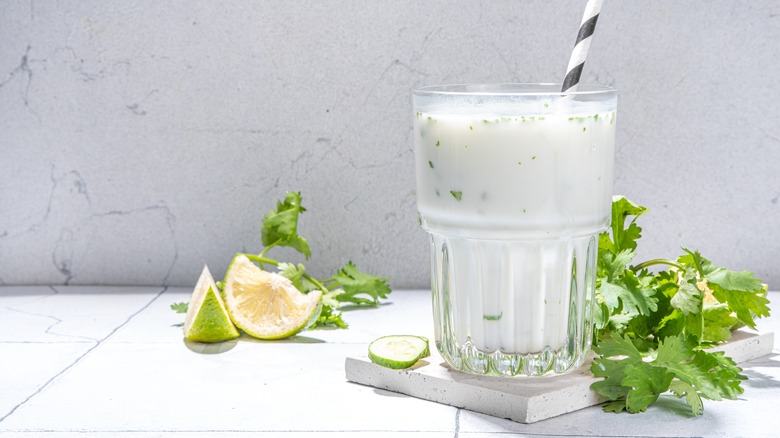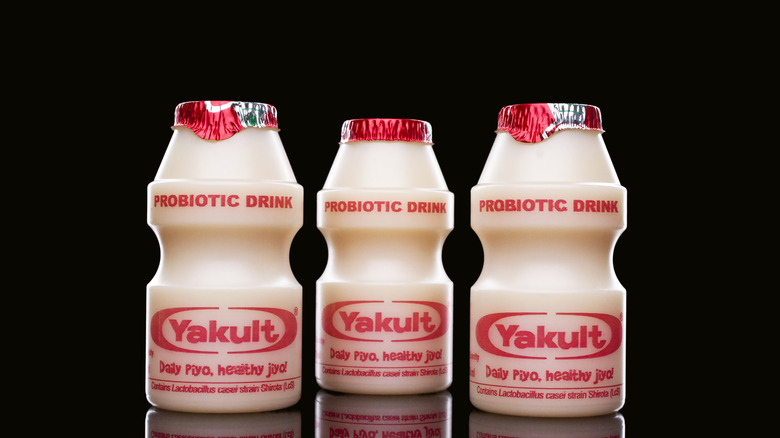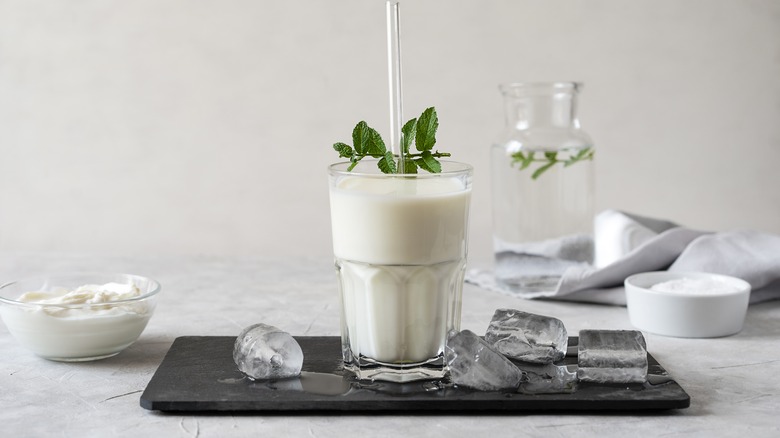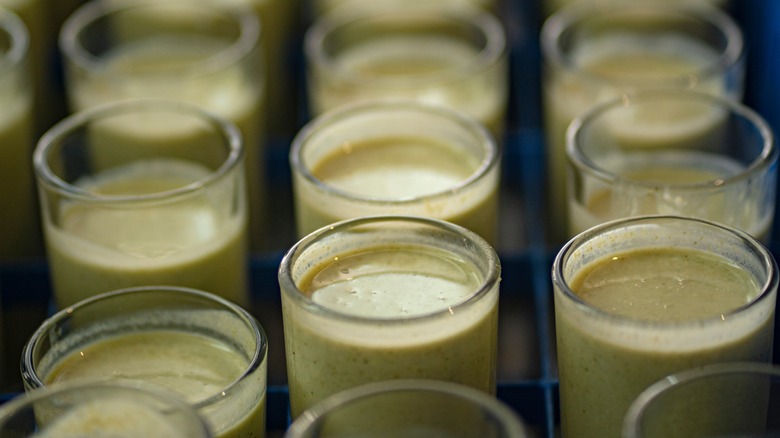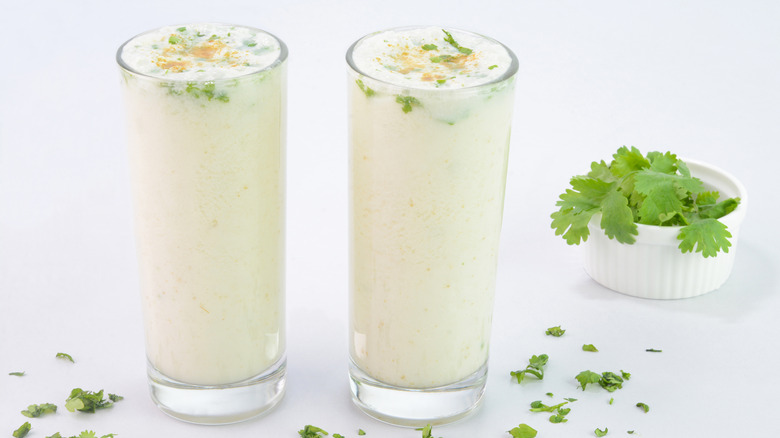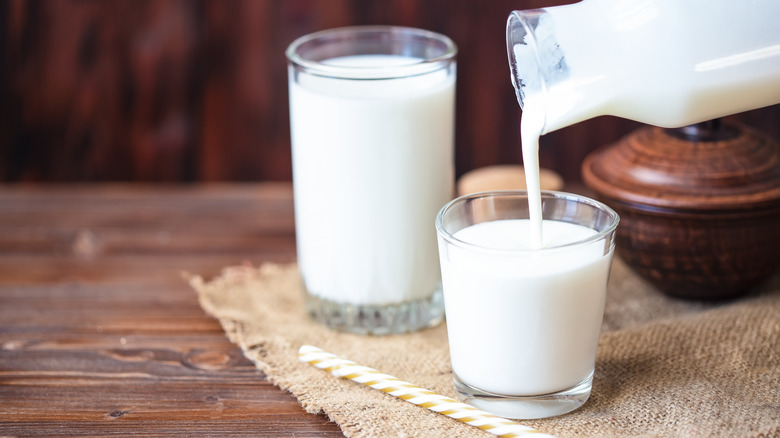12 Yogurt-Based Drinks Around The World
Not just for smoothies, breakfast parfaits, or on-the-go breakfasts, yogurt-based drinks have been a popular refreshment around the globe for centuries. From China to South Africa, Armenia to India, fermented yogurt drinks are often considered a daily ritual, as popular and widely available in some countries as soft drinks like Coca-Cola.
Much of their popularity comes down to the built-in electrolytes, digestive aides, and immune-boosting properties. Their satiating, slightly sour flavor often associated with fermented yogurt drinks can also be especially cooling and refreshing in countries with hot, dry climates.
Many yogurt-based drinks you'll find below have undergone a natural fermentation process. Whether mixed with water, salt, fruit, or rice wine, much of these processes and traditions span centuries, taste preferences, and spice varieties available. Here are some kinds of yogurt-based drinks to consider the next time you're craving something creamy or find yourself with an excess amount of yogurt in your fridge.
Lassi (Pakistan & India)
Lassi is perhaps one of the more well-known yogurt drinks, originating in India. The drink has been enjoyed since as early as 1000 BC. This cooling, sweetened yogurt drink serves not only as a tasty beverage but as an antidote to the country's oppressive heat. Unlike the U.S., where dragging a sweater along with you is customary to fend off the blasting air conditioning, most countries, regardless of climate, turn to foods or other customs for cooling effects. Some traditions stem from Ayurvedic principles around balancing the body's natural heat with various cooling foods.
Lassi is flavored with several ingredients, from mango to saffron to cardamom. Though sweet is often preferred, lassi can also be made savory with salt. Not just for hot days, lassi makes for a wonderfully cooling pairing to a spicy meal packed with heat, like in the regions of Kolhapur, Telugu, Andhra, Chettinad, and others in India.
Dairy Kefir (Russia/Eastern Europe)
All things fermented, from kombucha to kraut, to kefir, have become increasingly popular buzzwords across the U.S. as the importance of gut health has become increasingly acknowledged within the health field. Kefir is one living organism with many variations, including water kefir, originally from Mexico, that reads like a slightly funky soda and dairy kefir.
Dairy kefir is essentially a kefir grain-fermented milk, which takes on the sour notes and thickness of yogurt. This particular iteration is said to have originated in Eastern Europe some thousands of years ago. We can see other similar flavors from this part of the world, like the use and popularity of sour cream across many Eastern European and Russian cuisines.
Dairy kefir is not only a delicious drink, it is also highly nutritious. This probiotic is a great source of protein, calcium, and vitamin D, making it an excellent option at any time of day. With kefir grains readily available for home use, it is also a relatively simple product to make at home, allowing home cooks to play around with bespoke flavors and ingredients rather than being subject to whatever the local grocery store prefers to carry.
Amasi (South Africa)
Indigenous to South Africa, amasi, also known as maas is a refreshing fermented yogurt drink with a longstanding history in the area. Having been consumed for centuries by several indigenous South African communities, including the Zulu, Masai, Tsonga, and Xhosa, it has also played a significant cultural and nutritional role across a wide variety of communities, including some who would otherwise abstain from drinking fresh milk. The creamy, slightly sour drink, often containing visible soft curds, is an excellent probiotic and a refreshment whose popularity has since traveled to other areas of the continent.
Not just consumed on its own, amasi also plays a role in a variety of dishes, including amasi scones, pap, a porridge-like dish made from cornmeal or maize, bobotie, made with ground meat and raisins, and amasi chicken curry. Amasi was known to be one of Nelson Mandela's favorite foods, one in which he longed for during his wrongful incarceration.
Kumis (Central Asia & China)
Have you ever wondered what Champagne mixed with sour cream might taste like? According to some, kumis, a drink made in regions like Kazakhstan and across Central Asia for thousands of years, tastes just like the combination of these two ingredients. Made from mare's milk, known for its high sugar yield, kumis is safely fermented in vats until it becomes bubbly and fizzy from the alcohol-based carbonation created from the sugar itself. The drink also lent itself to a nomadic lifestyle due to its long shelf life and high energy content.
Unlike other animals whose milk is consumed by people, mare's milk must go through this fermentation or culture process in order to reduce the amount of lactose. The high amounts of milk sugars have a laxative-like effect making it not an excellent option for on-the-move consumption. Despite the high sugar/lactose being converted into alcohol to produce a tongue-tingling fermentation effect, there remains too little of it to be considered a naturally-occurring cocktail. Instead, it remains a traditional and nutritious drink of the area rather than a libation.
Nai Lao (China)
Not quite yogurt, not quite custard, nai lao is a longstanding treat from Beijing. Its name means imperial custard. Its texture, however, is probably more similar to a cold soup than a custard, often sweetened with sugar and garnished with nuts, seeds, and raisins for added crunch and chew.
Made from three parts full-fat milk or cream and one part rice wine, this dessert, served cold, is traditionally baked in wooden yogurt barrels, placed over hot coals. Modern techniques have evolved to allow chefs to recreate this dish more easily through a low-temperature steam bath until it is just about to reach boiling point, killing off any dangerous or unwanted bacteria and achieving the optimal texture. After the milk or cream and rice wine are whisked together and fully cooked, which can take up to 30 minutes or so using the steaming method, the thin dairy-based custard is left to cool in the fridge before enjoying.
Laban (Middle East)
Laban, or lban, depending on which country you're in, is the name of the fermented milk beverage or food prevalent in North African regions like Morocco, and across the Levant, including Syria, Lebanon, Jordan, and parts of Turkey. While it can sometimes take the form of yogurt cheese, also known as labneh, more commonly, it comes in a drinkable form, similar to buttermilk.
Laban typically ferments for up to 24 hours before the fats are churned for butter. Much like a can of coconut milk will have solid chunks, considered coconut cream, and liquid or water, so, too, does laban. Traditionally, after the fats are churned into butter, the remaining liquid is strained, fermented at room temperature for several days, then enjoyed as a drink. Thanks to modern-day industrialization, chefs, and cooks can do this much faster to produce the popular drink in mass. Laban is enjoyed in various ways, including served cold as a refreshing drink by street vendors, served in the home after a meal to aid digestion, or incorporated into many foods and recipes.
Ayran (Turkey)
Ayran is a yogurt-based drink commonly found in Turkey. Its popularity has a longstanding history; historians have found evidence of its presence in Central Asia since around 1000 BC. So popular is ayran that it rivals soda products like Coca-Cola and is offered at fast food outlets like Burger King and McDonald's.
Like other drinks on this list, it is recommended to serve ayran cold for best results. Iran makes an incredibly refreshing and hydrating summer drink mixed with water and salt and is often combined with mint leaves and cucumber and served over ice. The cooling drink's preferred thickness will depend on the region in which it's consumed. It tends to be made to a thicker consistency in southern Turkey.
Thanks to ayran's lactic acid bacteria, the drink is also suitable for supporting gut health and can help replenish electrolytes lost when sweating through Turkey's hot and sunny summers. While you can drink ayran on its own, it can also be made into tasty desserts like panna cotta or substituted into piña colada-like cocktails.
Yakult (Japan)
The now popular fermented probiotic drink known as Yakut began as a project by Dr. Minoru Shirota in the 1930s. Shirota, a doctor, was deeply concerned with the number of infectious diseases in the country that resulted from poor nutrition or hygiene. He began studying preventative medicine, including the positive effects lactic acid bacteria in the gut had in fighting infections. In 1935 the first bottle of Yakulk, a thin, slightly sweet, slightly creamy drink, hit the market. Though it is not officially considered yogurt, its similarities are so close that we believe it makes a good candidate for this list, especially given its health benefits and global popularity.
Thanks to Dr. Shirota's mission, research, and efforts, Yakult is not only delicious but also considered a FOSHU — Food for Specified Health Uses, an official category in Japan. Though originally born in Japan, Yakult has become a popular drink in many countries. It first reached Hong Kong in the late 1960s, then took off in markets across Asia, including Thailand, Korea, the Philippines, and Singapore, before expanding across continents. Yakult is now sold in at least 45 countries globally.
Doogh (Iran)
So popular is dough throughout Iran that The Tehran Times referred to the cooling, yogurt-based drink as the "Persian Coke." The beverage is also incredibly popular in Afghanistan, Armenia, Syria, Iraq, and Azerbaijan as a cooling antidote when it's just too hot to eat. Though each will have its own name, specified consistency, usage, or bespoke mix-ins, fermented dairy products are standard throughout Persian cuisine and the cuisines of other neighboring countries. That is precisely why there are so many different fermented, yogurt-based drinks from this area of the world on our list.
Doogh is considered the drink of ancient Persia; the name is derived from the Persian word dooshidan, which means milking. Cold and sour, dough is also carbonated or fizzy — a result of the natural fermentation process and the addition of club soda or seltzer. These characteristics make the drink both refreshing and good for settling upset tummies, boosting the immune system, and as a digestion aid. Doogh is often served in tall glass bottles similar to the original Coca-Cola bottles, which adds to its categorization as a soft drink rather than something thicker like a lassi.
Borhani (Bangladesh)
Meet lassi's savory cousin, borhani. While we often associate the word lassi with sweeter flavors, borhani is a more savory version of this drink. Originally from Bangladesh, borhani is blended with fresh herbs like mint and cilantro and warming spices like chaat masala, black pepper, or Kashmiri chile powder. Borhani is also often made using mustard seed as a predominant flavor, balanced with fresh ginger, giving them a distinguishing orangey color and flavor that makes it pop.
Like chaas below, borhanis make for a cool and refreshing savory accompaniment to any meal, or they can be served alone as an antidote to the region's very hot climate. Given their probiotic properties, they are also often consumed after a spicy meal to aid with people's digestion. Borhani also makes a popular drink during iftar, the meal eaten after sunset, a traditional fast-breaking practice observed during the holy month of Ramadan.
Chaas (India/South Asia)
Buttermilk lovers will delight in the rich, tangy flavors of chaas, a popular cultured drink across India. Chaas traditionally uses a tool known as a makhani, but a blender or whisk will also work fine. The madhani helps churn together cold water with plain yogurt, known as dahi. When the liquid becomes slightly thick and foamy, it's ready to drink.
Like many other yogurt-based drinks on this list, chaas are incredibly customizable to suit tastes and preferences. Simply add whatever spice or seasoning suits your palate, from a pinch of salt to toasted cumin or mustard seeds, curry leaves, fresh ginger, and more. For those wishing to add additional whole spices or other seasonings to your chaas, it is recommended to do so in the churning process rather than afterward. Chaas is best enjoyed chilled, whether with a meal or simply as a refreshment. The longer it is left to sit, the more sour and tangy it becomes, mimicking the taste of buttermilk.
Tan (Armenia)
Rather than Coke or Pepsi products, a yogurt-based drink known as tan is considered one of the most popular soft drinks throughout Armenia. The name comes from the main ingredient, a fermented milk with a yogurt-like consistency known as matsun. Made from cow, goat, sheep, or buffalo milk, matsun has been used for hundreds of years in various dishes throughout Armenian cuisine.
The base of any good tan involves mats, water, and salt. Matsun is first whipped together with the salt before pouring as little or as much water as desired to achieve your preferred thickness. This drink is an incredibly refreshing option, especially when chilled, making it a popular summertime drink to help cope with Armenia's heat. There are many different ways to make and enjoy tan. Some enjoy adding finely chopped greens, herbs, spring onions, or even cucumber to the mix for a boost of refreshing and savory flavors.
